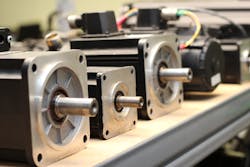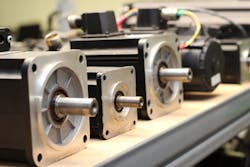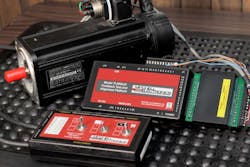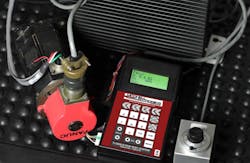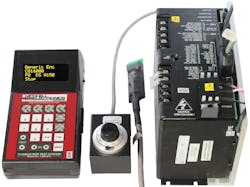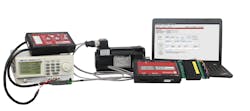It’s Now Easier than Ever to Bring Servo Motor Repair In-house
Technology in the form of robots, cobots, CNC cutting machines, autonomous vehicles and other forms of automation have increasingly found their way onto the manufacturing floor. These machines have a measurable impact on production, allowing manufacturers to meet rising production targets along with the growing expectations of customers and shareholders alike.
As the use of these machines increases, so does the reliance on servo motors. Providing power and precision, servo motors are the controlling force behind much of this equipment. Because of this reliance, the maintenance, preventive maintenance and repair of these motors is critical. When servos are taken offline for unscheduled repairs, the results are unnecessary factory downtime. And that translates into lost revenue, dissatisfied customers and frustrated stakeholders.
Manufacturers can maximize the performance of servo motors and extend their life by following some basic steps:
- Follow the manufacturer’s maintenance schedule.
- Pay attention to the surroundings.
- Eliminate trial-and-error guesswork.
There are no secrets or silver bullets. As with any piece of equipment, it all boils down to taking the time to do the little things and having the proper tools to dive deeper into potential issues.
Maintenance
All equipment require maintenance at some point. Regular inspections keep machines operating efficiently and prevent small problems from becoming big issues.
Following the manufacturer’s recommended maintenance schedule for your servo motors and implementing a regimented preventive maintenance program will extend equipment life and boost production. Here are some checks that you should perform as a part of your daily, weekly, monthly and yearly servo motor maintenance:
- Look for cracks or other damage on the housing.
- Look for loose or detached connections.
- If the servo has a fan-cooled motor, clean the fan unit so that it’s free of any dust or dirt.
- If your servo has a liquid-cooled motor, check to ensure the correct liquid is being used and the piping is not clogged.
- Check the belts and pulleys for wear or loose tension.
- Make sure the mounting is stable, look for any broken welds.
- Make sure gearboxes are filled to recommended levels.
Surroundings
While performing your visual inspection ensure that the servo motors are well ventilated and away from any excessive heat sources. While extreme temperatures, dirt, grease and limited airflow are a part of daily operation for most industrial equipment, these factors together with heavy load demands will ultimately take a toll on equipment—and servo motors are especially vulnerable.
READ MORE: How to Build a Better Rat Trap—with 70 Synchronized Servo Axes
Eliminate the Guesswork
So, you believe that you have a faulty servo motor. Now what? In the past, manufacturers would nearly always send the servo to a repair facility or return it to the manufacturer for repair—essentially shutting down the machine or production line, before knowing the true status of the motor.
Today, a growing number of manufacturers are embracing this technology and taking a proactive approach to servo motor inspection and repair, according to Stuart Mitchell, vice president, Mitchell Electronics, Inc., a provider of servo motor test systems. The company’s tools are used to diagnose servo problems.
“This ability to perform a diagnosis in-house has significant impact,” explained Mitchell. “Pinpointing the problem areas eliminates subjective trial-and-error and allows repairs to be focused where needed. This saves time and costs. Savings not only in terms of the repair itself but in significantly minimizing downtime and its impact on production.”
Servo Motor Testers and Repair
Now manufacturers can quickly diagnose servo motors on the spot to accurately pinpoint issues. This slashes downtime by only repairing motors that are truly defective. Lead times on certain repairs can be reduced from several weeks to a matter of hours.
Mitchell Electronics, Inc. recommends a 12-step process to effectively document, troubleshoot and validate servo motors repairs. Below is an overview of this process. A detailed look can be found here.
1. Document the Motor
It’s important to document the information pertaining to the servo motor. Generally found on the motor’s nameplate, this information often includes everything from the manufacturer, model and serial number to the amperage, volt and RPM rating.
“Creating and maintaining a data sheet is the best way to capture, document and maintain information about the servo motor,” said Mitchell. “Having this information on hand is essential to effectively repairing the motor.”
2. Document the Power Connection
Servo motors typically have separate connections for power and feedback. The servo drive connects to the motor through the power connector to make it spin. Photographing the power connectors helps to document this power connection. It’s also recommended to label wire colors and pin numbers because incorrect power connections during the feedback alignment process are a common cause of defects. Many power cables and pinouts are listed on the Bobcat Online Database.
3. Document the Motor Winding Resistance
Next, connect an Ohmmeter to the pins on the power connector and check for any short circuits. You should also verify a normal range of resistance. Unbalanced resistance readings between phases or low resistance from a phase to ground could indicate shorted windings or shorts to ground.
4. Determine the Number of Motor Poles
Servo motors contain permanent magnets and it’s necessary to know how many magnet poles the motor has to properly align the feedback device. Because this information isn’t typically found on the motor name plate, it must be determined using the following procedure, which is also shown in the video below:
- After unlocking the brake, set DC lockup supply to half the rated current (Amps) of the motor and apply current to a set of power pins and mark the current position of the motor shaft relative to the motor frame.
- After removing the current, physically turn the motor before reapplying the current. Determine how many times the shaft locks up in a single rotation.
- The number of possible lockup positions on the motor will equal the number pole pairs. Multiply pole pairs by 2 to get the total number of motor poles.
5. Determine the Forward Direction of the Motor
Systematically apply voltages to different pairs of pins and observe the direction that the shaft turns. This indicates the motor’s forward direction. Each time the voltage is changed on the pins the shaft will turn and lock into position. By following a specific pattern of voltages, we determine if the motor has a clockwise or counterclockwise forward direction.
This step is demonstrated in the following video using Mitchell’s TI-5260-PSP Permanent Magnet Servo Motor Rotor Lockup System.
Setup instructions are shown here:
Knowing the forward direction of the motor is necessary. Incorrect forward direction can indicate incorrect power wiring.
6. Determine the Ke Rating
The Ke rating number is usually found on the nameplate. It is a physical property of the motor and can be verified empirically.
Connect the motor under test to a separate servo motor. Typically, one would spin the motor by applying voltage to the pins. However, this step takes the opposite approach by turning the motor and measuring the generated voltage from the pins. This verifies that the amount of voltage coming off the pins is what’s expected for the motor. Low Ke could indicate winding or magnet problems.
7. Document the Feedback Connection
Encoder wires run through the motor chassis and out to the connector. This connector provides signals to drive the motor.
In step 2 we documented the power connector. Now it’s time to do the same for the feedback connector. This helps to identify pin function, wire pinout, color and so on. Many feedback cables and pinouts are listed on the Bobcat Online Database.
8. Test and Document the Feedback Device
Before we can diagnose the encoder, we need to identify its model or style. This can sometimes be determined from the motor part number on the motor nameplate. At other times the motor housing must be opened to read the encoder part number or otherwise identify it.
Mitchell’s Athena software displays encoder counts and commutation states. It calculates and displays mechanical and electrical angles for diagnosis and simplifies adjustment during the encoder alignment process. Special diagnostic tests have been developed to confirm counting, verify encoder error codes and check encoder voltage levels and phase angles. Proper feedback operation is essential for servo motor commutation.
9. Document the Forward Direction of the Feedback Device
With the TI-5000JX attached to the feedback connector, rotate the motor. The TI-5000JX collects the data and feeds it to the Athena software. This displays results to let you know if the feedback device is counting up (increasing) or counting down (decreasing).
By observing which rotational direction causes increasing counts, we can determine if the feedback has a clockwise or counterclockwise forward direction. Correct feedback forward direction is essential for feedback alignment.
10. Document the Current Alignment of the Feedback Device
If the servo motor isn’t properly aligned, it simply will not work. Stuart Mitchell recommends documenting the servo motor’s alignment angle prior to disassembly.
“Knowing the alignment of the encoder’s connection to the motor is nothing short of critical,” he said. “Attempting this manually often causes problems because a slight misalignment of more than three electrical degrees can prevent the motor from running or cause it to overheat or run inefficiently.”
(To help ensure proper alignment, many companies utilize the company’s TI-5000JX product.)
11. Document the TI-3000JX Setup Position
It’s nearly time to simulate the motor’s performance prior to returning to service. One approach is to attach the motor to a drive created especially for that specific motor. However, this isn’t always feasible or cost-effective for manufacturers or service shops dealing with multiple servo motor brands/types.
Mitchell’s TI-3000JX product is a generic solution used to run tests on a wide variety of servo motors. The system provides fast and reliable information to determine that the motor is likely to function properly when reinstalled to service in the machine. Information from steps 1-6 of this process is entered into the TI-3000JX to prepare the system to test the servo motor.
12. Debug, then Run the Motor
Before running the motor rotate the motor by hand to ensure that signals appear to be correct. This is explained in the video below:
Pressing the “run” key enables the run test. The motor can be run forward, reverse, to maximum speeds and so on to ensure there is no excessive heat, vibration, noise or anything out of the ordinary.
Need More?
Manufacturers have traditionally lacked a process to diagnose, troubleshoot and repair servo motor issues. Instituting these processes in-house reduces costs and turmoil related to unplanned downtime. Watch this video to learn more about servo motor inspection and repair:
Robert Farrell is the owner of Farrell Marcom Services, LLC.
